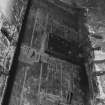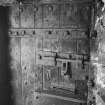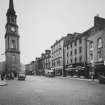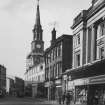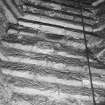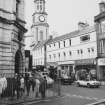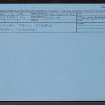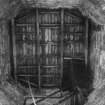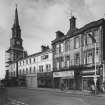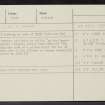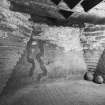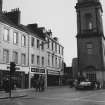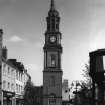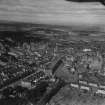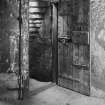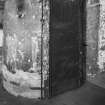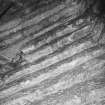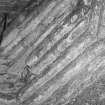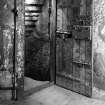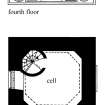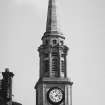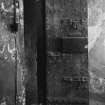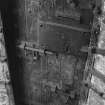Falkirk, High Street, Town Steeple
Clock Tower (19th Century), Steeple (19th Century), Tolbooth (Period Unassigned)
Site Name Falkirk, High Street, Town Steeple
Classification Clock Tower (19th Century), Steeple (19th Century), Tolbooth (Period Unassigned)
Canmore ID 46747
Site Number NS87NE 10
NGR NS 88824 79913
Datum OSGB36 - NGR
Permalink http://canmore.org.uk/site/46747
- Council Falkirk
- Parish Falkirk
- Former Region Central
- Former District Falkirk
- Former County Stirlingshire
NS87NE 10 88824 79913
(NS 8882 7991) Lock-up on site of (NAT) Tolbooth (NR)
OS 1:500 map (1860)
Falkirk Town Steeple was built in 1813-4 on the foundation of an earlier steeple, dating from 1697 (NSA 1845). The earlier building was used as a prison until the end of the 18th century when it was allowed to become ruinous (Name Book 1860) and it was removed in 1803.
RCAHMS 1963, visited 1956
The Town Steeple still occupies this site.
Visited by OS (JP) 10 January 1974
NS87NE 10 88824 79913
ARCHITECT: David Hamilton, 1813-14.
Publication Account (1996)
This imposing structure stands at the E end of the wide central section of High Street, which was used as a marketplace. It was built in 1813-14 to the designs of the Glasgow architect, David Hamilton. It replaced a steeple of 1697, which was demolished in 1803 after subsidence caused by the removal of the adjacent tolbooth, on whose site a four-storeyed block was built.
Hamilton employed a range of neo-classical motifs in the upward transition from a square base to an octagonal spire, and in 1815-16 he used a modified form of the design for the steeple of Port Glasgow Town Buildings (No.73). Both steeples bear strong points of similarity to that of St Enoch's Church, Glasgow, with which Hamilton was no doubt already familiar and which he preserved in his own rebuilding of that church in 1827-8.
The steeple measures 6.15m square on plan and 42.7m in height, and is free-standing except on the E, where the large building of about 1800 has been replaced by lower structures. It is built of yellow sandstone ashlar, with channelled masonry in the lowest stages. At ground-floor level there are a round arched entrance-doorway to the S and a large window in the W front, both having fanlights, and above these at third-floor level there are large fictive square-headed windows. At the next stage each face is treated as a Doric portico, having a pediment supported by angle-columns and enclosing a deepset round-headed window. The stage above this is an unequalsided octagon, with panelled pilasters framing clock-faces on the four longer sides. The belfry is a regular octagon with square-headed louvred openings between attached Ionic columns which carry an elaborate double cornice. This is in turn surmounted by a short octagonal stage from which the spire tapers to a ball-finial and weather-cock bearing the date 1814.
While the ground floor was originally leased as a shop, the first floor served as ajailer's room and the second and third floors as cells, which about 1834 were fitted with iron-cased doors. Access up to third-floor level is by a spiral stair in the NE angle, but above that it is provided by wooden stairs. The fifth floor is at the level of the clock, which has a modern mechanism. In the belfry above there hang two bells, the larger of which was cast by Thomas Mears of London and installed in 1816. It is 1.13m in diameter and is inscribed: MAY FALKlRK FLOURISH 1815. The other bell was cast in 1897 by John C Wilson, Glasgow, to replace one from the late 17th-century steeple, which is now in Falkirk Museum. This measures 0.66m in diameter and is inscribed: lAMES EARLE OF LINLlTHGOW AND CALLANDER IOHN MEIKLE FECIT EDINBURGI / 1697 FOR FALKlRK..
HISTORY
The building occupies the site of two earlier steeples, the first of which was built in the 16th century. This was replaced in 1697 by a steeple with a forestair and a steeply-pitched double-ogival roof, built by a local mason, William Stevenson, at a cost of 700 merks. This steeple was itself demolished in 1803 after subsidence caused by the removal of the adjacent tolbooth to the E, and the construction on its site of a four-storeyed building. A consequent legal action between the Falkirk stentmasters, owners of the steeple, and the owner of the new block, caused a delay of some ten years before the present building was begun. It was erected by a local mason, Henry Taylor, at a contract price of £ 1,660, and has remained virtually intact, although the spire required repair after lightning-damage in 1927.
Information from ‘Tolbooths and Town-Houses: Civic Architecture in Scotland to 1833’ (1996).

































